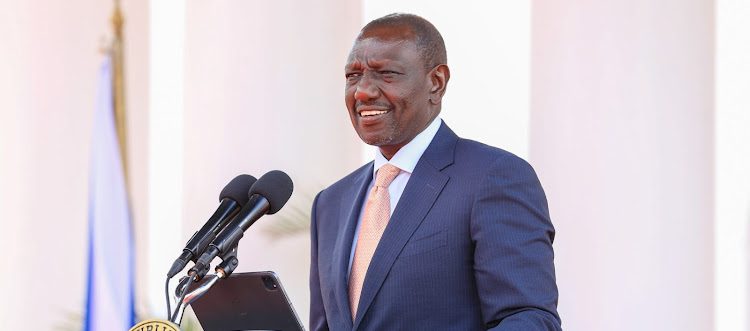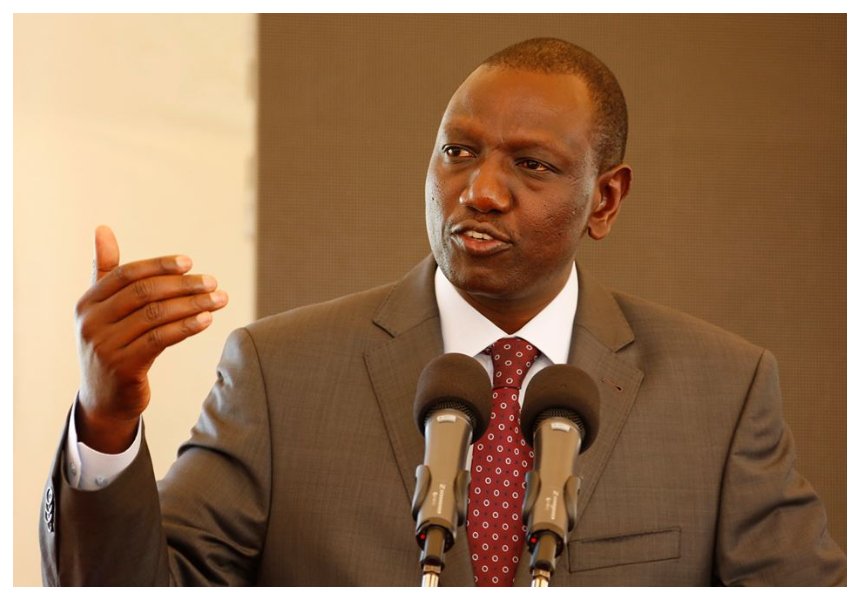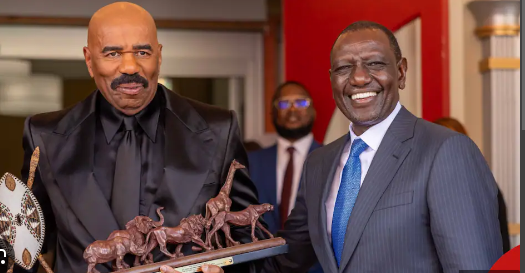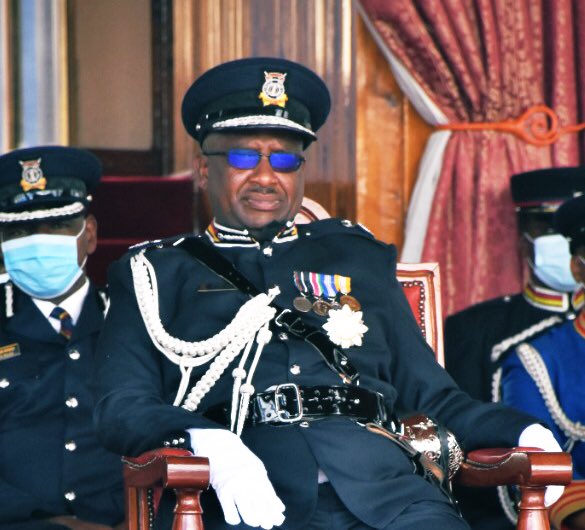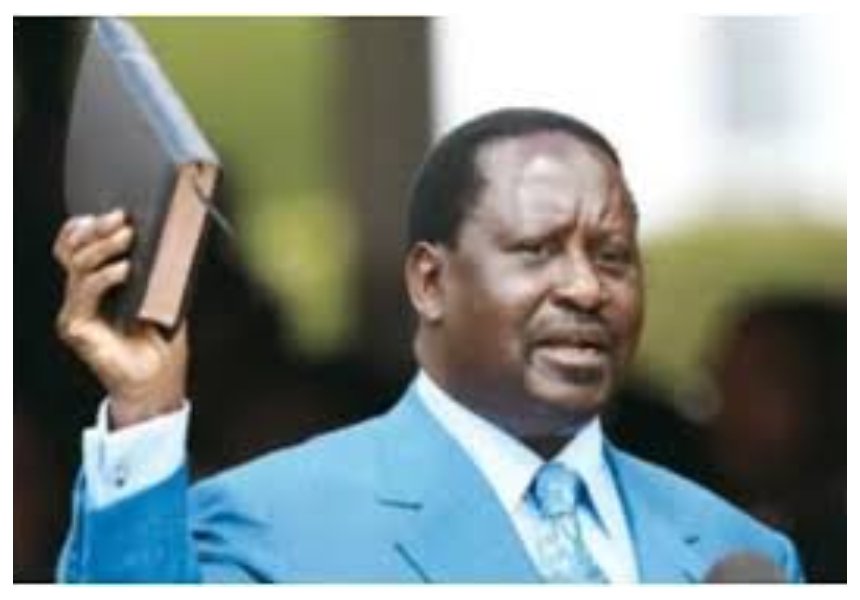Nairobi, February 25, 2025 – Chaos reigned in Nairobi’s Central Business District (CBD) today as students from the Technical University of Kenya (TUK) took to the streets in a fiery protest against the prolonged closure of their institution. The demonstration, which saw police deploy tear gas to disperse the crowd, underscores the deepening crisis in Kenya’s higher education sector, with TUK at the epicenter of a standoff between students, lecturers, and the government.
The unrest began in the morning when hundreds of TUK students gathered, armed with placards and chants, demanding immediate government intervention to reopen their university. The institution has been indefinitely shuttered since February 3, following a lecturers’ strike over unpaid salaries—a grievance that has festered since September 2024. Today’s protest saw students march toward the Ministry of Education headquarters at Jogoo House, hoping to confront Education Cabinet Secretary Julius Ogamba and press for answers. However, their procession was met with a heavy police presence, and tear gas canisters soon filled the air, scattering the crowd and disrupting activities across the CBD.
The students’ frustration stems from weeks of academic limbo. On February 3, TUK’s University Senate suspended all diploma and undergraduate examinations scheduled for February 3-15, citing an ongoing industrial action by staff affiliated with the Universities Academic Staff Union (UASU) and the Kenya Universities Staff Union (KUSU). The university ordered students to vacate campus premises that same day, leaving thousands stranded with no clear timeline for resuming studies. The lecturers’ strike, which began on January 23, was sparked by months of delayed salary payments and unremitted statutory deductions, issues that have crippled operations at the institution.
Today’s demonstration marked a boiling point for students who feel abandoned by both university management and the government. “We’ve been out of class for weeks, and no one seems to care,” one protesting student lamented as clouds of tear gas billowed around Haile Selassie Avenue. “Our future is at stake, and we won’t stay silent while TUK collapses.” The students’ chants of solidarity echoed through the streets, with some calling for broader accountability, including references to national leadership—a sentiment that has surfaced in similar protests across Kenya’s public universities.
The police response was swift and forceful. Videos circulating online showed officers lobbing tear gas canisters and pushing back students who had ventured close to key government buildings, including the National Treasury and Harambee House. The heavy-handed tactics drew criticism from onlookers, but authorities maintained they were necessary to restore order in the busy commercial hub. Traffic ground to a halt, and motorists were forced to seek alternative routes as the standoff unfolded.
This is not the first time TUK has faced such turmoil. In October 2023, lecturers staged a similar protest in Nairobi’s CBD over delayed September salaries, accusing the university of mismanaging funds disbursed by the government. Today’s events suggest that little has been resolved since then, with the institution now grappling with debts—including a reported KSh 4.1 billion owed to the Kenya Revenue Authority (KRA)—and chronic underfunding. The 2021-2025 Collective Bargaining Agreement (CBA), valued at KSh 9.7 billion, remains unimplemented, further fueling discontent among staff.
Higher Education Principal Secretary Beatrice Inyangala has acknowledged the crisis, stating earlier this month that a Technical Committee is working with TUK management to devise a sustainable recovery plan. “You cannot just wake up overnight and dream up a recovery plan for an institution that has been mismanaged for years,” she said, urging patience as discussions continue. Yet, for students and lecturers alike, patience is wearing thin. The closure has not only disrupted academic schedules but also jeopardized graduation timelines and future opportunities for thousands of learners.
As tear gas dissipated over Nairobi’s skyline this afternoon, the underlying issues at TUK remain unresolved. The students’ bold stand today signals a growing unrest that could ripple across Kenya’s public universities, many of which face similar funding woes. Without swift action from the Ministry of Education and the Treasury, the crisis at TUK risks becoming a symbol of a broader failure to prioritize higher education—a failure that, as one student put it, “history will not forgive.” For now, the streets of Nairobi bear witness to a generation fighting for its future, one protest at a time.
Tag: Maandamano news
Ruto as Catalyst for Change: More Than Just Rhetoric
The presidential office is a potent symbol of power and influence. But beyond the pomp and circumstance, the true measure of a leader lies in their ability to translate promises into tangible change. While the road to transformation is fraught with challenges, several key strategies can guide President Ruto and his government in their pursuit of a better nation.
Vision
Firstly, a president must be a visionary. This means Ruto must set a clear, inspiring, and achievable agenda. It’s not enough to identify problems; solutions must be proposed and communicated with conviction. A compelling vision can galvanize public support and motivate the necessary actions.
Understanding
Secondly, effective leadership demands a deep understanding of the people. William Ruto must be attuned to the hopes, fears, and aspirations of the citizenry. This requires more than mere polling data; it demands empathy, active listening, and a genuine commitment to public service. By connecting with the people at a human level, a president can build trust and create a shared sense of purpose.
Team-building
Thirdly, a president must be a skilled builder of coalitions. Change rarely happens in isolation. It requires collaboration across diverse groups, including political opponents, business leaders, civil society organizations, and international partners. President Ruto must be adept at negotiation, compromise, and consensus-building to forge the alliances needed to drive progress.
Accountability
Fourthly, accountability is paramount. Ruto must be willing to be held accountable for his actions or inactions. This means transparency in governance, access to information, and a willingness to admit mistakes. By fostering a culture of accountability, a president can inspire confidence in the government and encourage citizen participation.
Advocacy
Lastly, a president must be a relentless advocate for their people. Whether it’s championing economic growth, improving education, protecting the environment, or promoting social justice, a president must be unwavering in their commitment to the public good. This requires courage, resilience, and a willingness to stand up for what is right, even in the face of opposition.
It is essential to recognize that change is a gradual process. Quick fixes and superficial solutions are often counterproductive. Sustainable progress requires patience, persistence, and a long-term perspective. A president who embodies these qualities is more likely to leave a lasting legacy.
Ultimately, the success of a president in driving change hinges on their ability to inspire, unite, and lead. By combining vision, empathy, coalition-building, accountability, and advocacy, a president can become a catalyst for positive transformation.
Leadership: The Achilles Heel of Social Change
Traditional models of social movements often revolve around charismatic figures – the Martin Luther Kings, the Nelson Mandelas. Their undeniable power to inspire and galvanize masses is undeniable. Yet, an emerging counter-narrative suggests that perhaps the most effective movements are those that eschew leadership altogether. This is what the Gen Zs in Kenya are trying to achieve.
The Tyranny of the Singular Voice
History is replete with examples of movements derailed or co-opted by the ambitions of their leaders. A single point of failure, be it imprisonment, assassination, or simply a loss of moral compass, can cripple an entire cause. Moreover, leadership can stifle dissent, homogenize perspectives, and ultimately, diminish the authenticity of the movement’s message.
Distributed Power, Distributed Risk
Leaderless movements, on the other hand, distribute power across a network of autonomous cells. This decentralized structure is remarkably resilient. If one cell is compromised, the movement as a whole is not fatally wounded. It also fosters a diversity of tactics and strategies, increasing the likelihood of finding approaches that resonate with the public and confound opposition.
Empowerment from Within
In a leaderless movement, agency rests with the individual participants. This fosters a sense of ownership and commitment that is difficult to replicate in hierarchical structures. People are more likely to take risks, make sacrifices, and think creatively when they feel they have a genuine stake in the outcome.
The Illusion of Control
While the idea of a leaderless movement might seem chaotic or disorganized, it often masks a sophisticated level of coordination and strategy. Information can flow freely, ideas can be shared rapidly, and decisions can be made with remarkable speed. This agility can be a decisive advantage in the fast-paced world of social activism.
A Word of Caution
It’s important to note that leaderless movements are not inherently superior to those with leadership. There are contexts where a strong, unifying voice is essential. However, as the world becomes increasingly complex and interconnected, the limitations of traditional leadership models become more apparent.
In Conclusion
Leaderless movements offer a compelling alternative to the top-down approach that has dominated social change for centuries. By prioritizing decentralization, empowerment, and resilience, they have the potential to reshape the very fabric of our societies. As we grapple with the urgent challenges of our time, it is imperative that we explore new and innovative ways of organizing for collective action. Perhaps the future of social change in Kenya lies not in the hands of a few, but in the collective power of the many.
Ruto Orders The Release of Protestors From Prison
William Ruto has ordered the immediate release of individuals who were peacefully protesting in various parts of Nairobi yesterday.
In a national address today, President Ruto expressed condolences to the families who lost loved ones. He directed that those who were inadvertently caught in the events be released and charges against them dropped.
Regrettably, there were instances of excessive, unlawful, and harmful behavior during the demonstrations, resulting in numerous arrests and charges,
William stated.
I urge law enforcement agencies to swiftly release individuals who were innocently caught up and not involved in criminal activities, withdrawing any charges against them.
This decision aims to enable agencies to concentrate their efforts on investigating and prosecuting serious criminal offenders who exploited yesterday’s peaceful protests to vandalize both public and private property.
Journalists Stage Countrywide Protests Against Police Brutality
We must put an end to the threats against journalists.
Harassment, censorship, and physical attacks must stop immediately.
Journalists are being targeted while covering protests and this is unacceptable.
Protect press freedom in Kenya!
No journalist should ever be killed or injured in the line of duty. They are the voice of the people, and their safety is paramount.
Journalists play a crucial role in upholding democracy and ensuring the public is informed. Their work allows us to hold leaders accountable and shine a light on the truth. We must create and maintain a safe environment for all journalists to perform their duties without fear of retribution.
To ensure our voices were heard, we staged protests across the nation from Nairobi, to Mombasa, Kisumu, Nyeri and Uasin Gishu. The footage can be found below:
JOURNALISTS in Nairobi, Mombasa, Kisumu, Nyeri, Uasin Gishu hold demonstrations against police brutality on the media during protests. pic.twitter.com/2yW3zDq57e
— CapitalFM Breaking News (@BreakingNewsKE) July 24, 2024
We must put an end to the threats against journalists.
Harassment, censorship, and physical attacks must stop immediately.
Journalists are being targeted while covering protests and this is unacceptable.
Protect #PressFreedomKE!
No journalist should ever be killed or… pic.twitter.com/N4XAbAjyow
— The Elephant (@theelephantinfo) July 24, 2024
Journalists nationwide are staging peaceful protests to oppose the surge in violence against them, a troubling trend seen since the onset of anti-government demonstrations in Kenya last month.
Video by @SamMunia pic.twitter.com/paNPxmaqfG
— Africa Uncensored (@AfUncensored) July 24, 2024
William Ruto Names the Remaining Cabinet Secretaries
President William Ruto last week named 10 Cabinet secretaries, with a promise to name additional nominees soon. Today he has done so, with a cabinet that includes some Azimio officials and 5 CSes recycled from the previously dismissed Cabinet. The additional nominees are:
1. NATIONAL TREASURY & ECONOMIC PLANNING – John Mbadi
2. INVESTMENTS, TRADE & INDUSTRY – Salim Mvurya
3. TOURISM & WILDLIFE – Rebecca Miano
4. ENERGY & PETROLEUM – James Opiyo Wandayi
5. YOUTH AFFAIRS, CREATIVE ECONOMY & SPORTS – Onesmus Kipchumba Murkomen
6. MINING, BLUE ECONOMY & MARITIME AFFAIRS – Hassan Joho
7. LABOUR & SOCIAL PROTECTION – Dr. Alfred Mutua
8. COOPERATIVES, MSMEs & DEVELOPMENT – Wyckliffe Oparanya
9. PUBLIC SERVICE & HUMAN CAPITAL DEVELOPMENT – Justin Muturi
10. GENDER, CULTURE, ARTS & HERITAGE – Stella Lang’at
Boda Guys Clash in CBD After Some Are Suspected to be Looters
Today there was a heavy boda boda presence in the Nairobi Central Business District due to some holding placards saying, “Tumechoka na Gen Z; Give Ruto Time to Work.” You can see my full coverage of that story here:
Boda Guys Ride With Placards: “We Are Tired Of Gen Zs, Give President Ruto Time”
As a further development to that story, we now have some factions of boda guys coming out to say that some of them in town are crooks. Thieves being paid to disturb the peace. In a video captured by BTG News, some boda guys were quoted saying that some of them were stealing from civilians. Meanwhile the police appeared to stand idly by. One said:
Mbona hawajapigwa teargas? Na wanaibia watu wakienda. Ameiba simu mbili nikiona. Polisi wanaangalia tu.
Another one chimed in saying:
Hawa majamaa wameekewa mafuta mahali nimetokea. Kwa petroli ya Ng’ang’a wameekewa mafuta ya ngiri na wanapewa thao
Get the full video of all the interviews here:
For any protestors out there today, be careful of the scavengers in your midst!
The Perils of Prolonged Protest
Protests are a cornerstone of democratic societies, a powerful tool for citizens to voice their grievances and demand change. Yet, the efficacy of these demonstrations can be significantly diminished when they extend beyond a critical juncture. While the initial surge of energy and unity is essential, prolonged protests can have unintended consequences that undermine their original goals.
Firstly, prolonged protests can lead to a decline in public support. Initially, the public may be sympathetic to the cause, but as disruptions to daily life persist, patience can erode. The initial wave of solidarity can turn into frustration and resentment, potentially damaging the movement’s reputation.
Secondly, the focus of the protest can become diluted. As time passes, the initial, clear demands may become obscured by a myriad of issues. This lack of focus can make it difficult for both protesters and policymakers to find common ground and reach a resolution.
Furthermore, prolonged protests can create a climate of instability and uncertainty. Businesses may hesitate to invest, tourism may decline, and the overall economic health of a region can suffer. This economic downturn can disproportionately affect those who are most vulnerable, exacerbating the very issues the protest was intended to address.
It is essential to recognize that protests are a means to an end, not an end in themselves. While they can be a catalyst for change, they must be accompanied by other forms of activism, such as lobbying, advocacy, and electoral engagement. A well-rounded approach that combines different tactics is more likely to yield lasting results.
In conclusion, while protests are a vital tool for democratic societies, their effectiveness is maximized when they are focused, time-bound, and complemented by other forms of activism. By understanding the potential drawbacks of prolonged protests, we can ensure that these demonstrations are used strategically to bring about positive change.
Sizeable Protests Escalate in Machakos
We have had anti-government protests across the country today, with crowds forming in Nairobi, Kitengela, Mombasa, Eldoret and now Machakos. It appears that despite the concessions by the Ruto government after the Finance Bill protests, there still remain some sections of the population that feel that the actions he took were not satisfactory. In Machakos, a sizeable crowd formed on this cold Tuesday afternoon to storm the streets in protest:
Happening now in Machakos! pic.twitter.com/TMEnhy5BU5
— Omwamba 🇰🇪 (@omwambaKE) July 16, 2024
One resident was interviewed by the media and he claimed that he did not like the dialogue solutions proposed by some leaders. He says he wants action rather than dialogue:
Machakos Resident: Once bitten twice shy. We have had a dialogue before in this nation but the results are the same. For us, we want action and not dialogues.#K24Siasa pic.twitter.com/3gGYSRmAy9
— K24 TV (@K24Tv) July 16, 2024
Another Machakos resident sent a stern warning to Machakos Governor Wavinya Ndeti, saying that they are coming for her:
Machakos Resident: We want to send a stern warning to the governor of Machakos. We are coming for you. We are ready to die.#K24Siasa pic.twitter.com/QE93wd2el6
— K24 TV (@K24Tv) July 16, 2024
There were also some attempts to free captured protestors. Crowds formed outside the police base to stand in solidarity
The police however, retaliated, using teargas to diperse the crowd
Heavy security deployment around Machakos Police Station after protesters threatened to set free those arrested in the demos pic.twitter.com/wDV7ejfsPL
— Citizen TV Kenya (@citizentvkenya) July 16, 2024
Police Forced by the Crowd to Release a Protestor They Had Captured
In a stunning show of solidarity, protestors in the Nairobi City CBD today confronted the anti-riot police. They wanted the cops to release one of the protestors who was captured. The unarmed group faced of with the police who were armed to the teeth with all kinds of anti-riot gear. After approaching close enough, members of the crowd could be heard saying:
“Mbona anashikwa? Achana na yeye”
In English, this means “Why is he being caught? Leave him alone.”
The police then proceeded to claim that the captive person was a “chokoraa” aka a homeless person. Very insensitive remarks, to which the protestors appropriately responded, asking them,
“Kwani chokoraa si mtu?
Translation: “Is a homeless person not a person?”
After the pressure from the crowd became too much, the police finally relented and released the man. You can see the video of the incident in full here:
Kitengela Sees The Largest Protests of the Day
Today we had anti-government protests in parts of Nairobi, Eldoret, Kitengela and Mombasa. They were mostly muted, but in Kitengela the people came out in numbers to support the cause. Police were quickly overwhelmed and just let the demonstrators do their thing. Here are all the images we could gather from the proceedings:
Over there in Kitengela, Gen Zs have not only told the police to go back to their families, but they’ve also decided to escort them there. They will not believe. pic.twitter.com/VUTOmJI48i
— Gabriel Oguda (@gabrieloguda) July 16, 2024
Happening now in Kitengela!!! pic.twitter.com/MQtsxfGORx
— Omwamba 🇰🇪 (@omwambaKE) July 16, 2024
Protestors escort police back to their camp peaceful in Kitengela #Maandamano pic.twitter.com/G65g9jHRDd
— The Kenyan Vigilante (@KenyanSays) July 16, 2024
Anti-gov’t protesters on a police vehicle in Kitengela, Kajiado County. pic.twitter.com/Y6oJ9LB0pO
— Hot 96 FM Kenya (@Hot_96Kenya) July 16, 2024
Protestor Fatally Wounded In Today’s Protests
A protestor has been shot dead in the anti-government protests happening today in the Nairobi CBD. Footage of the said protestor going down were captured by the YouTube channel Kenya Online Media which you can see below:
Go to minute 3:50 to see the gruesome footage for yourself. Viewer discretion is advised.
We stand in absolute condemnation of police brutality. The use of excessive force against any citizen, regardless of circumstance, is an egregious violation of human rights and a betrayal of public trust. These acts not only inflict physical harm but also cause deep emotional trauma and erode the very foundation of a civil society – the belief that all people are treated with dignity and respect under the law.
The duty of law enforcement is to protect and serve, not to brutalize. A thorough and impartial investigation should be conducted into this incident, with those found responsible held fully accountable.
Furthermore, we urge a systemic review of police practices to ensure that de-escalation tactics are prioritized and officers are equipped with the training and resources necessary to resolve situations peacefully. Building trust between law enforcement and the communities they serve is paramount.
Police brutality undermines public safety. It breeds fear, anger, and distrust. We cannot and will not tolerate such actions. We call for immediate action to end this violence and ensure justice prevails.
Police Storm Nation Media Group Headquarters
We have received footage of police entering Nation Center in the CBD during today’s protests
Perhaps it is time to remind the police of their limits.
In the complex tapestry of a functioning society, few threads are as vital as media freedom. It serves as the cornerstone of a healthy democracy, empowering citizens and holding power accountable. By enabling the free flow of information and ideas, a free press fosters a society that is informed, engaged, and ultimately, stronger.
One of the most crucial roles of a free media is acting as a watchdog. Without independent journalists investigating and reporting on the actions of governments and institutions, corruption and abuse of power can flourish in the shadows. A free press shines a light on these issues, exposing wrongdoing and prompting necessary reforms. This ensures that those in power are held to account, preventing them from acting with impunity. The government, which includes the police as an arm of the judiciary, should never think of stepping foot into a media house’s office like they have today.
Furthermore, media freedom fosters an informed citizenry. By providing diverse perspectives and in-depth analysis on current events, the media equips people with the knowledge they need to make informed decisions. This is especially important in a democracy, where citizens have the power to shape their government through voting and public discourse. A free press empowers them to participate effectively by providing them with the tools to critically evaluate the issues at hand. Let us not go back to the Moi days where all media was merely a propaganda tool for the government.
Media freedom is not a luxury, but a necessity. It safeguards democracy, empowers citizens, and fosters a more just and equitable society. By ensuring the free flow of information and ideas, a free press allows us to hold power accountable, make informed decisions, and engage in meaningful public discourse. In a world that often craves control, media freedom stands as a beacon of truth and a powerful tool for positive change.
IG Koome Alleges Azimio Hired Dead Bodies to Claim Police Brutality
Inspector General of Police Japhet Koome has sensationally alleged that the opposition Azimio La Umoja One Kenya Alliance coalition hired dead bodies from mortuaries and claimed they were victims of police brutality during recent demonstrations.
Koome made the allegations during a press conference on Monday, August 8, 2023. He said that the police have evidence to support their claims, and that they will be sharing it with the public soon.
Azimio has denied the allegations, and has called for Koome to resign. They say that the allegations are baseless and defamatory.
The demonstrations in question took place in July 2023, after Azimio announced its presidential candidate, Raila Odinga. The demonstrations were met with a heavy police presence, and there were reports of police brutality.
The United Nations has called for a probe into the deaths of several people during the demonstrations. They have expressed concern over the widespread violence and allegations of unnecessary or disproportionate use of force by police.
The allegations by Koome have reignited the debate over police brutality in Kenya. It remains to be seen whether the police will be able to provide evidence to support their claims.
In the meantime, the allegations have cast a shadow over the upcoming general election, which is scheduled to take place in August 2023.
Two brothers die from injuries allegedly inflicted by police during anti-government protests
A family in Kisumu is mourning the deaths of two sons who died from injuries allegedly inflicted by police during anti-government protests two weeks ago.
Brian Oniango and William Amulele, both in their early 20s, died just three days apart while receiving treatment at the Jaramogi Oginga Odinga Hospital’s intensive care unit.
Their mother, Everlyne Achung’o, says that Amulele died on Saturday night, while Oniang’o succumbed on Wednesday.
“The doctor said Brian had a cracked skull which caused his death, and when William died, the doctor told me he had a broken neck and cracked skull,” she said in an interview with Citizen TV.
Achung’o insists that her sons were not taking part in the demonstrations called by the Opposition Azimio to protest against the high cost of living and the controversial Finance Act, 2023.
The demonstrations, which were characterized by violent scenes in several parts of the country, were held between July 19-21.
The family has sent an emotional appeal to President William Ruto and Azimio leader Raila Odinga, the two protagonists whose differences informed the mass protests.
“Let him (Ruto) not praise the police that they have done a good job, let him order for investigations,” the boys’ aunt Truphena Mboya said.
“And I call on Raila wherever he is to stop the protests because people’s children will continue losing their lives,” she added.
On Tuesday, Raila termed the alleged police brutality in Nyanza during anti-government demonstrations as ethnic profiling and cleansing.
The Opposition chief said in his address to international media that “they are targeting one particular community and that is not the route that we want Kenya to take”.
“They are targeting the Luos in Nyanza. That is why there is a disproportionate use of live bullets in areas like Migori, Homa Bay, Kisumu and Siaya,” he claimed.
The Opposition, human rights organizations and foreign missions have condemned the police for using live bullets and disproportionate crowd control weapons like teargas and water cannons against demonstrators.
No official statistics have been released, but the Opposition claimed that at least 50 people were killed, although some rights groups said it’s roughly half the number.
Interior CS Kithure Kindiki on Tuesday, July 25, issued a statement absolving police from alleged extrajudicial killings, saying the criminal acts were perpetrated using civilian guns and the blame shifted to the police.
“It has been established that licensed and unlicensed civilian firearms supplied by the masterminds of the recent violence were used to kill or injure civilians and security personnel, and the blame shifted to security officers,” he said.
The family of the two brothers is demanding justice and an independent investigation into their deaths.
Raila Odinga Explains Why He’s Missing In Action In ‘Maandamano’ Protests
Azimio la Umoja One Kenya coalition party leader Raila Odinga has said that he is recovering from a flu, which is why he has not been seen in public since the anti-government protests began on Wednesday.
Odinga, who did not disclose his current whereabouts, said that he was feeling slightly unwell but that he is on the mend. He also denied claims that he and other coalition leaders are hiding, saying that they are leading the protests from different parts of the country.
On why his co-principals, including Narc Kenya Party leader Martha Karua and Wiper’s Kalonzo Musyoka, have not been leading the demonstrations as they have always done, Odinga said that the protests are for all Kenyans and that it is not mandatory for them to be present.
Odinga also slammed President William Ruto and his Kenya Kwanza team, accusing them of prejudice in their utterances and constant calls for peace. He vowed to continue with the protests.
According to Odinga, the President has not personally called him to discuss the way forward and he has not demanded a ‘handshake’ as Kenya Kwanza leaders have continuously alleged.
Odinga’s explanation comes after some Kenyans expressed concern about his whereabouts and whether he was still committed to the protests. The protests were called in response to the recent increase in fuel prices.
The protests have been met with a heavy police presence, and there have been reports of violence and arrests. Odinga has called on the police to exercise restraint and to allow the protesters to exercise their right to assembly
Schools in Nairobi, Mombasa, and Kisumu to Reopen on Thursday
The government has announced that all day primary and secondary schools in Nairobi, Mombasa, and Kisumu counties will reopen on Thursday, July 20, 2023.
The decision to reopen the schools was made after the government evaluated the security situation in the counties and took measures to ensure the safety of learners.
On Tuesday, July 19, 2023, the government had closed all day primary and secondary schools in the three counties citing security threats.
The government said that it had received credible intelligence that criminal elements were planning to unleash terror and violence on the public, and that they intended to engage in armed skirmishes with security agencies around certain schools.
Schools in the three counties obeyed the directive, and an earlier spot check by the Star showed closed gates in several schools, including Moi Avenue Primary School in Nairobi.
The government has said that it has taken steps to ensure the safety of learners, including deploying additional security personnel to the schools.
The reopening of the schools is a welcome relief for parents and learners, who have been anxiously awaiting news about when they would be able to return to school.
The government has urged parents and learners to be vigilant and to report any suspicious activity to the authorities.
It is important to note that the security situation in the country remains fluid, and the government may need to take further measures to ensure the safety of learners.
Police Officer Faces Disciplinary Action for TikTok Video
A police officer who posted a video on TikTok in which he made political remarks is facing disciplinary action.
The officer, who has not been named, was seen in the video reading comments from his followers about the current administration of President William Ruto and the ongoing protests.
“Zakayo must go, Ruto must go… imagine kila mtu anasema Ruto must go… mimi ni comments nasoma tu (everyone is saying Ruto must go… I’m just reading comments),” the officer says in the clip.
Some of the phrases used by the officer, who was with a colleague, are used by Azimio la Umoja – One Kenya Coalition in their anti-government protests.
The policeman is also heard saying that “dialogue is the only solution and it must come immediately.”
The National Police Service has condemned the officer for making misleading and reckless remarks.
“As a Disciplined Service, we wish to clarify and assure the public that the behaviour portrayed in the clip is not only unacceptable but also doesn’t reflect the values of NPS,” a statement from the National Police Service reads.
The police termed the officer’s remarks as regrettable and that they have embarked on an internal review with a view of preferring appropriate disciplinary action.
The National Police Service also said it remains focused on training its officers to the highest standards.
This development comes at the height of anti-government protests by Azimio la Umoja – One Kenya Coalition.
The third wave of demonstration by the opposition coalition started on Wednesday in several parts of the country and will continue on Thursday up to Friday.
On Wednesday, Nairobi’s CBD remained calm but it was deserted as business people and traders failed to show up for fear of being caught up in the protests.
The officer’s actions have been condemned by Kenyans on social media, who have called for him to be dismissed from the police force.
It remains to be seen what disciplinary action will be taken against the officer, but his actions have highlighted the need for police officers to be more careful about what they say and do in public.
Maandamano continues tomorrow
Kenyans are scheduled to take to the streets for three days of protests against the government’s policies. The protests are being organized by the Azimio coalition, led by Raila Odinga.
In a statement, Homa Bay Town MP Peter Kaluma said that the protests are a result of the way President William Ruto is leading the country. He cited concerns such as the high cost of living, the government’s hunger for borrowing, and the targeting of democracy and multi-partyism.
Kaluma also criticized the government for muzzling independent offices and commissions, stalling talks for electoral reforms, and becoming arrogant and dictatorial.
He urged the government to stop the protests by returning the Finance Act, 2023 to Parliament for repeal, restructuring the government to reflect the face of Kenya, and stopping corruption.
Transport CS Kipchumba Murkomen has urged Odinga to call off the protests. He said that the issues being raised by the Azimio coalition can be discussed in parliament.
It remains to be seen whether the protests will go ahead as planned. However, the fact that they are being organized by a major political coalition suggests that they could have a significant impact on the country.
Maandamano Wednesday: Power outages in these estates
Parts of Nairobi, Machakos, Kiambu, Nyamira, and Mombasa counties will experience a power outage on Wednesday, July 19, 2023, due to normal maintenance activities by Kenya Power.
In Nairobi County, the affected areas include Red Hill Road, Gachie, Nyari West, Karura Seventh Day Adventist church and secondary school, Commission for University Education, Rosslyn Green, Embassy of Switzerland, TRIO Estate, and other adjacent customers.
In Machakos County, the affected parts include Katani, Rhombus, Bluestone, Suraya, National Concrete, VeeVee, Aristocrats, Kirinyaga, Mugoya, and Garuda.
Other areas within the same county are Greatwall Gardens Phase 3, St Franciscan Sisters, Whistling Morans, Harvest International, Waridi, Pine City, Nova Pioneer School, Seyani Brothers, Welding Alloys, Alrabia, Riverpark Estate, Graceland Estate, and adjacent customers.
The power interruptions will also affect the North Eastern part of Kiambu. The specific areas in which the power blackout will hit include Tola, Bob Harris, Ngoingwa, Metro, and Weitethie.
Others include Tola town, Kiahuria Shopping Center, Mpesa Academy, Albbizia, and adjacent customers.
Also parts of Ruiru and Mugutha towns will be affected by the power interruptions. The specific areas include Kenrub, Ukombozi, Magumo Farm, Part of Mugutha 4 Way, China Wuiyi, Ruiru Law Courts, Green Belt, the office of the district Commissioner, Taurus, Ridges, Comrades, Muhasibu, Yadini Farm, Elite Diaries, Njagu Estate, Ken Agro, Mahiga Estate in Ruiru and adjacent customers.
The power interruptions will also affect Nyamira County in South Nyanza Region. The areas include Kiriaini, Kamune, and Kagumoini.
The specific areas include Gatugi Market, Kiriaini Town, Munaini District Commissioner’s Office, Kamacharia, Kagumoini Market, Diara, Kanjama Market, Kora Market, Kamune Market, Iruri Market, and Thuita Market.
The other areas are Kiaga, Karuthi Secondary School, Geitwa Market, Kariki, Giathugu Iruri, Mairo Market, and other adjacent customers.
In Mombasa County, parts of Likoni will be affected by the blackout. Other areas include Co-operative Bank, Shelly Beach Hospital, St Thomas Hospital, Timbwani Hospital, Pungu Villas, Tijara, Majengo Mapema, Furaha Garden, Dudus, and Pungu.
Kenya Power has advised customers in the affected areas to make alternative arrangements for power supply during the maintenance period. The company has also apologized for any inconvenience caused.
Sondu Bay clashes mirror dark days
Narok Senator Ledama Olekina has warned that the tribal clashes in Kisumu and Kericho counties could lead to a war. He called on politicians to end their selfish interests and work towards peace.
The clashes, which have been ongoing for years, have been sparked by a long-standing boundary dispute between the two counties. On Thursday, two people were killed and 15 others injured in fresh violence.
Ledama said that the clashes are a result of politicians using the dispute to further their own agendas. He urged President William Ruto and Interior CS Kithure Kindiki to stop inciting violence and work towards a peaceful resolution.
“We are getting drunk with power,” Ledama said. “Our own selfish interests will destroy our beautiful country!”
He called on the two leaders to remember that political power is transient and that they should focus on building a better future for Kenya.
The clashes in Sondu market have been a major source of tension between the Kisumu and Kericho counties. The two counties differ over the location of the boundary which demarcates the two counties. This has led to intermittent clashes over the years, with the most recent violence occurring on Thursday.
Ledama’s warning is a timely reminder of the dangers of tribal conflict. He is right to say that politicians must put their own interests aside and work towards peace. The future of Kenya depends on it.
Maandamano suspects released on bail
More than 90 suspects who were detained on Wednesday in Eastlands, Nairobi, following protests by members of the Azimio la Umoja – One Kenya Coalition were charged in court on Thursday with participating in an illegal assembly in violation of section 79 of the penal code.
The majority of the suspects were apprehended in the estates of Makongeni and Shauri Moyo on Jogoo Road. Within the Embakasi East sub-county, other people were detained in Jacaranda, Savannah, and Dandora estate.
One of the defendants, a 15-year-old boy, acknowledged that he was detained while taking part in the violent demonstrations.
One of the defendants, a 15-year-old boy, acknowledged that he was detained while taking part in the violent demonstrations.
Charges of assaulting police officers in the proper performance of their duties in violation of section 103 (a) of the National Police Service Act of 2011 were brought against several of the accused who reportedly stoned police officers dispersing the protestors.
During the protests, two police officers from the Shauri Moyo and Makongeni Police Stations suffered injuries.
Many of the accused, who asserted that a police officer struck them when they were being arrested, were unable to stand when they were arraigned before the Makadara Law Courts in Nairobi and were therefore unable to be charged.
Prior to filing charges, Senior Principal Magistrate Helen Okwani ordered that the suspects be brought to a hospital for treatment. The injured suspects are to be arraigned for a plea hearing on July 20, 2023, the magistrate further directed.
The rest of the accused entered a variety of defenses, with the bulk disputing the allegations against them.
Those who had added charges of assaulting police officers were freed on a cash bail of Sh30,000 while those who had only been charged with participating in an unlawful assembly were released on a cash bail of Sh5,000.
Lawyers Samuel Ayora and Rachel Nyambura defended each suspect. The detainees’ attorneys appealed for moderate bail and bond conditions.
More than 24 people are facing charges for allegedly hitting a police officer with a stone, but the officer is still alive, Mr. Ayora informed Ms. Okwani.
The defendants who entered a guilty plea were remanded in custody until July 17, 2023, when the prosecution will present its case against them and they will be found guilty and sentenced.
Sights and sounds from Nairobi CBD








Police Crack Down on Maandamano
Police in Nairobi on Wednesday morning cracked down on protests against the high cost of living, deploying anti-riot officers and blocking roads leading to the State House.
The protests were organized by the Azimio La Umoja Coalition and other civil society organizations, who were calling for the government to take action to address the rising cost of food, fuel, and other essential goods.
Police said that the protests were illegal because they had not been properly authorized. They also warned that anyone who participated in the protests would be arrested.
Despite the police crackdown, some protesters did manage to gather in small groups in different parts of the city. However, they were quickly dispersed by police.
The protests come at a time when the cost of living in Kenya is at an all-time high. The government has been criticized for its handling of the economy, and many Kenyans are struggling to make ends meet.
It remains to be seen whether the protests will have any impact on the government’s policies. However, they have certainly brought attention to the issue of the high cost of living, and they are likely to continue in the coming days.
Dozens Arrested as Police Disperse Saba Saba Protesters in Nairobi
Dozens of people were arrested along Harambee Avenue in Nairobi on Friday morning as police dispersed protesters who had started to converge at the site of the Saba Saba rally.
The protesters, who were calling for an end to corruption and the high cost of living, were met with tear gas and arrests by police in plain clothes.
Heavy rains appeared to have prevented many protesters from attending the rally, but those who did brave the elements were determined to make their voices heard.
At Kamukunji Grounds, where Azimio leaders were due to address a rally, youth danced to various beats to keep warm as they waited for their leaders.
“The rain will not stop us from holding our maandamano. We must demonstrate against this regime,” said one youth.
The rally was eventually called off due to the heavy rains, but the protesters’ message was clear: they are not going to give up until they see change in Kenya.
Police Authorize Saba Saba Gathering in Nairobi, but Only at Kamukunji Grounds
Police in Nairobi have authorized the organizers of the Saba Saba gathering to hold the event at Kamukunji Grounds, but not in the Central Business District (CBD). The head of the Nairobi police, Adamson Bungei, said that the decision was made in order to prevent any potential unrest.
Some businesses in the CBD remained closed on Friday morning out of fear of violence. Bungei urged the organizers of the rally to cooperate with the police and to ensure that the event is peaceful.
Earlier in the day, a group of protesters tried to block Thika Road, but they were dispersed by police. The protesters were reportedly angry about the high cost of living in Kenya.
Police have also been deployed to other parts of the city in anticipation of further protests. The organizers of the Saba Saba rally have said that their protests will be peaceful.


